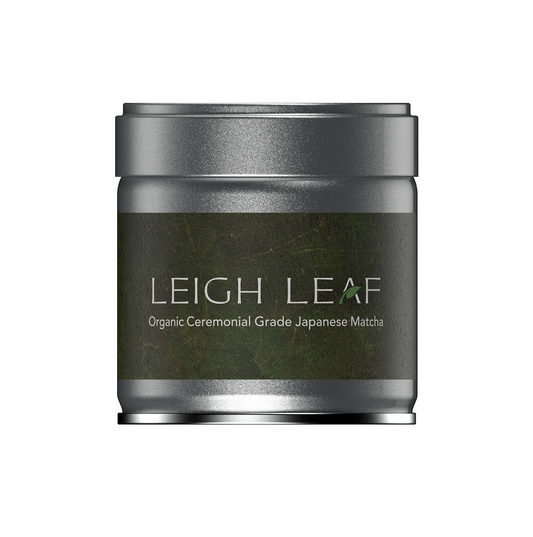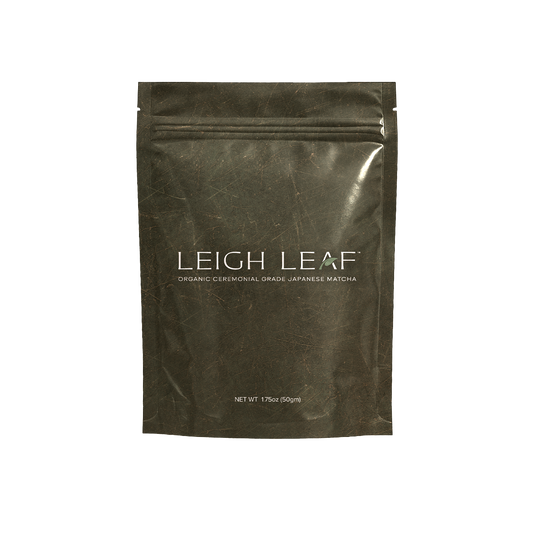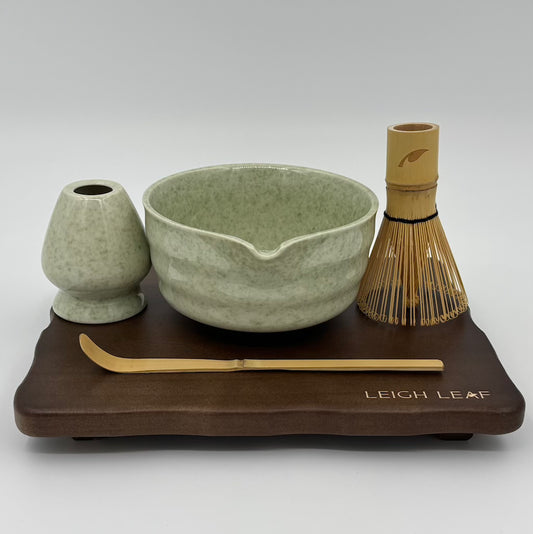
Matcha Chronicles: Where Tradition Meets Modernity
Share
Matcha, the vibrant green elixir that has been captivating the hearts and taste buds of people around the world, is far more than just a trendy beverage. In this article, we're diving deep into the world of matcha to unravel its secrets, exploring its meaning, the meticulous cultivation process, the ancient tencha furnace, the art of grinding, and even the different definitions of matcha.
Table of content
How Do You Define Matcha?
Before we delve into the nitty-gritty of matcha, let's start with the basics: What does matcha actually mean? Matcha means "powdered tea" in Japanese. This already provides us with a glimpse into the essence of matcha—it's tea in its most finely ground form.
But there's more to it than that. Matcha is not just any powdered tea; it's a highly specialized type of green tea with a rich history and a unique preparation method that sets it apart from other teas.
Shaded Cultivation: The Birth of Matcha's Distinct Flavor
One of the key factors that distinguishes matcha from other green teas is the way it's grown. The process of growing matcha leaves is called "shaded cultivation." Before harvesting, the tea plants are covered with shade cloths.
This shading technique serves a variety of functions. Firstly, it enhances the flavor and aroma of the tea leaves. Plants produce more chlorophyll and amino acids, especially L-theanine, when exposed to less direct sunlight. This gives matcha its distinctive umami flavor and vibrant green color.
Additionally, shading reduces the bitterness of the tea leaves, making matcha a smoother and more enjoyable drink. This meticulous cultivation process highlights the importance of quality in the world of matcha.

The Tencha Furnace: Where Matcha Transformation Begins
A series of intricate steps transforms tea leaves into matcha after they are harvested. The first of these steps takes place in the tencha furnace, which plays a crucial role in shaping the flavor and texture of the final product.
Freshly harvested leaves are steamed inside the tencha furnace to prevent oxidation. This steaming process preserves the vibrant green color and the nutrients of the leaves. As the leaves dry, they become tencha, a precursor to matcha.
This careful handling ensures that the tea leaves retain their unique characteristics and sets the stage for the next step in the matcha-making process.
The Grinding Machine: Turning Tencha into Matcha
The highlight of matcha production is undoubtedly the grinding process. This is where tencha is transformed into the fine, velvety powder that we associate with matcha.
Traditionally, matcha was ground using stone mills, a slow and labor-intensive process. However, modern methods have introduced grinding machines that can meticulously pulverize the tencha leaves into the desired consistency.
The result is a vibrant green powder with a talcum-like texture. This finely ground powder is what makes matcha so unique and versatile, as it can be used not only for brewing tea but also for culinary creations like matcha lattes, ice creams, and pastries.

Matcha Definition: Broadly-Defined Matcha and Narrowly-Defined Matcha
Now that we've explored the journey of matcha from cultivation to grinding, it's important to understand that there are two different definitions of matcha: broadly defined matcha and narrowly defined matcha.
Broadly-Defined Matcha
Broadly defined, matcha encompasses a wide range of green teas that have been ground into a fine powder. This includes various grades and qualities, from ceremonial grade matcha, which is the highest quality matcha available, to culinary grade matcha, which is used in cooking and baking.
The quality of the leaves used, the cultivation process, and the level of care taken during production determine matcha grades. It is considered to be the finest matcha and is used in traditional Japanese tea ceremonies. Its flavor is delicate and full of umami, and its vibrant green color is a testament to its quality.
Narrowly-Defined Matcha
On the other hand, narrowly defined matcha refers specifically to the highest-quality ceremonial-grade matcha. This is the matcha that is cherished for its exquisite flavor, vivid green hue, and the meticulous care that goes into its production.
Matcha, when narrowly defined, is not just a beverage but also an art form and a form of culture. It's a symbol of tradition and craftsmanship, and it holds a special place in the hearts of tea connoisseurs worldwide.
What Is the Definition of Matcha?
Now that we've explored the two definitions of matcha, let's answer the question: What is the definition of matcha? In essence, matcha is a unique type of powdered green tea that is characterized by its vibrant color, umami flavor, and versatile applications.
Matcha is not just a beverage; it's a reflection of Japanese culture, precision, and dedication to quality. It's a drink that has evolved over centuries, with each step of its production carefully curated to bring out the best in its flavor and appearance.
Whether you're sipping a bowl of ceremonial-grade matcha during a traditional Japanese tea ceremony or enjoying a matcha latte at your favorite café, you're experiencing a taste of history and craftsmanship that has transcended time and borders.
Leigh Leaf’s Ceremonial-Grade Matcha
When it comes to experiencing the highest quality matcha, one name that often comes to mind is Leigh Leaf. With a commitment to sourcing only the finest tea leaves and a dedication to preserving the rich heritage of matcha, Leigh Leaf offers a selection of matcha that embodies the true essence of this green elixir.
Leigh Leaf's matcha is sourced from regions known for their premium tea leaves, ensuring that each sip is a journey into the heart of matcha culture. Leigh Leaf's matcha offers a memorable and authentic experience to anyone who enjoys powdered green tea.
In conclusion, matcha is more than just a trendy drink; it's a centuries-old tradition that continues to enchant people with its unique flavor, color, and cultural significance. From shaded cultivation to the tencha furnace and the grinding machine, every step in the matcha-making process is a testament to the dedication to quality that defines this remarkable beverage.
So, the next time you sip on a cup of matcha or savor a matcha-infused treat, remember that you're not just enjoying a beverage; you're immersing yourself in a rich history and a world of flavor that is truly one-of-a-kind.
Whether you prefer broadly defined matcha for its versatility or narrowly defined matcha for its exquisite quality, matcha has a place in the hearts of tea lovers around the globe. It's a drink that transcends borders and time, bringing people together to celebrate the art and culture of powdered green tea.
So, raise your matcha bowl and toast to the magic of matcha—a vibrant green elixir that continues to captivate and inspire. Cheers to matcha, the tea that defies definition and defines tradition.




